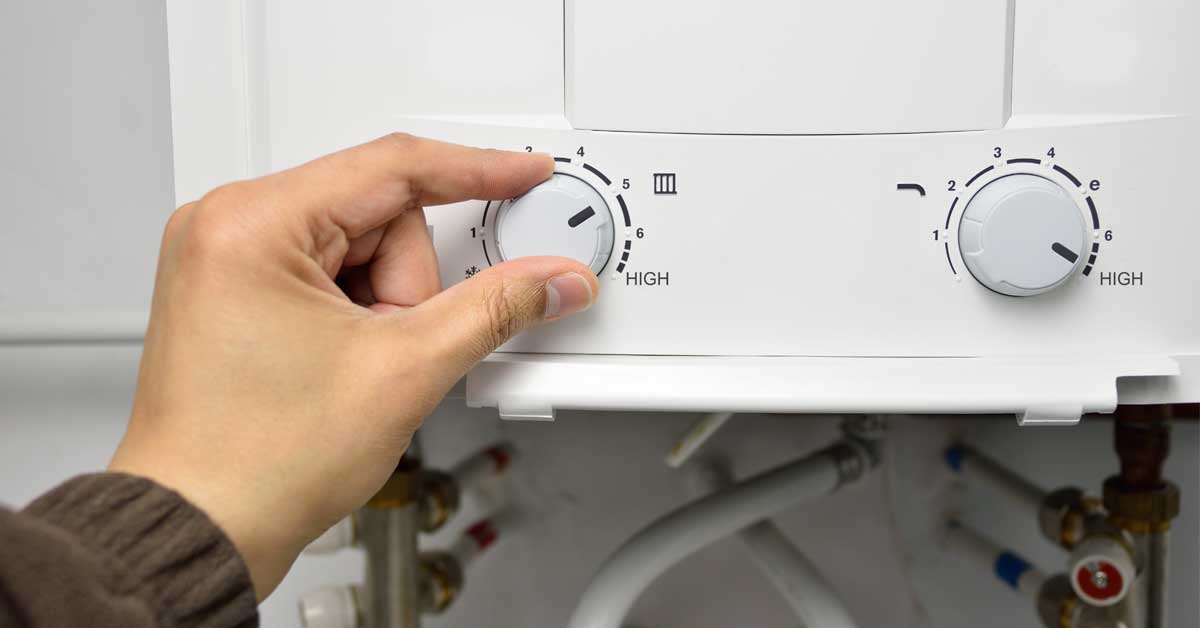How to Descale Your Tankless Water Heater

Every appliance that uses water collects scale (calcium and lime build-up), including your tankless water heater. To function properly, all types of water heaters need descaling at some point.
However, it’s a bit more challenging to flush and descale a tankless water heater than a traditional tank water heater. The rate of scale buildup also depends on how hard the water is in your home. In this post, we’ll be showing you how to flush a tankless water heater with our recommended flush procedure.
Why Do Tankless Water Heaters Need to Be Descaled?
Scale collects inside your tankless water heater slower than in a tank. However, the build-up still affects a tankless water heater’s performance. The scale clogs up the heating elements, making them less effective.
Over time, this build-up will cause your heat exchanger to use more and more energy when heating your water. Eventually, the build-up may also restrict the flow of water. Depending on how long the machine goes without routine maintenance, the build-up may erode the walls of your tankless water heater to the point where it needs to be replaced.
How Often Should You Clean a Water Heater?
At Lenox Plumbing, we recommend having your first descaling treatment conducted three years after the initial installation of your tankless water heater. If sediment is found after the first flush, it is recommended to perform the descaling treatment again in three years. However, if sediment is not found, it is recommended to perform the treatment again in five years.
If you live in an area with hard water, you may need to flush your water heater more frequently. If you’re uncertain about water quality in your area, you can check with your city government. A trusted plumbing professional can also help you determine how often you need to flush out your water heater.
Taking Care of Exterior Maintenance
Caring for the outside of your water heater is also important. The good news is, exterior maintenance doesn’t require an extraordinary amount of time or supplies.
Start by wiping down the cover. Using a non-abrasive cleaner and a soft cloth will keep the unit free of dust as well as help to prevent rust development.
Next, inspect the pipes. Keeping an eye on pipes during cold weather is a good way to avoid finding them frozen.
Finally, if your tankless water heater has a pressure relief valve, you should test it.
Exterior maintenance typically takes about 20 minutes. Flushing the water heater will take a little longer.
How to Descale Your Tankless Water Heater
In order to access the tankless water heater, seek the help of a professional plumber. Tankless water heaters are installed in the walls of your home; therefore, disconnecting the heater and reconnecting it for the descaling process can be difficult, and is better suited to someone who is familiar with the system.
To descale a tankless water heater, you will need:
- A 5-gallon bucket
- 3 to 4 gallons of distilled, food-grade white vinegar
- 2, ¾ inch connection drain hoses
- A submersible pump
Note Before Starting: On the unit, the red isolator valve indicates the hot water side, while the blue isolator valve indicates the cold water side. Drain caps are located on top of the hot side and on the left of the cold side. Turning the valves to the vertical position indicates they are “on” and that water is free-flowing. Turning the valves to the perpendicular position indicates they are “off.”
- Keep the unit on but turn the gas valve off.
- Turn both the hot and cold valves off. Remove the drain caps on both valves. Place the five-gallon bucket underneath the hot water side. Carefully turn the red drain valve to the “on” position and use the bucket to drain the unit of any excess water still inside.
- Repeat step two on the cold water side.
- Connect a hose to the submersible pump and place the pump with the connected hose into the five-gallon bucket. Make sure the power cord stays out of the bucket.
- Connect the pump outlet hose to the cold water drain valve.
- Connect a drain hose to the hot water drain valve and place the end of the drain hose into the bucket.
- Dump the vinegar into the bucket so that the pump is completely submerged. Open both drain valve lever handles on the isolation valves and turn on the pump for at least an hour. For maximum effectiveness, change the vinegar solution after 30 minutes and repeat. The unit will try to fire up, but will fail due to the gas being off. Eventually, an error code 11 will appear, which is normal during the procedure. DO NOT RESET.
- After a minimum of one hour, turn the pump off and push the cold water drain valve shut. Remove the hose from the cold water drain valve and replace the cap onto the drain valve outlet.
- Remove the pump and drain hose from the bucket and drain the liquid. Place the hot water drain hose back into the empty bucket and open the cold water main valve. This procedure will flush out the heater with fresh cold water. Flush for at least five minutes or until 20 gallons of water have passed through the heater.
- For condensing units, place a bucket under the unit and twist open the drain cock located directly under the water heater to drain out any descaling medium that may have collected in the unit. Turn the main inlet valve to the “OFF” position.
- For additional maintenance, unscrew and remove the water filter for cleaning—some water may flow out. Clean the filter under running water to remove any debris. Place the dry filter back into the port, making sure it’s twisted tightly by hand.
- Turn the drain valve to the “OFF” position. Unscrew and remove the drain hose. Replace the drain cap and make sure it’s screwed on tightly.
- Turn the main hot and cold valves back to the “ON” position and turn the gas supply back on. To get rid of the error code 11 that resulted from descaling, reset the unit by powering it off, then powering it on again.
Why Choose a Professional for Tankless Water Heater Descaling?
Your tankless water heater touches all of the drinking water in your home. You wouldn’t want to accidentally do something to jeopardize your water if you descale your tankless water heater incorrectly.
To ensure the process has been done correctly, it’s always better to trust a professional to descale your tankless water heater.
Need to Schedule Tankless Water Heater Maintenance?
Keeping up with maintenance, including a regular tankless water heater flush, should take place at least once a year. You may need to take care of other tasks more often, like wiping down the exterior of the unit, especially if the area attracts a lot of dust. Installing a sump pump to protect your basement appliances may also be a good idea.
While you can take care of basic maintenance on your own, why not let our team help? We’re always happy to schedule routine descaling and annual service for both tankless and standard tank water heaters. Contact Lenox today for an estimate!


